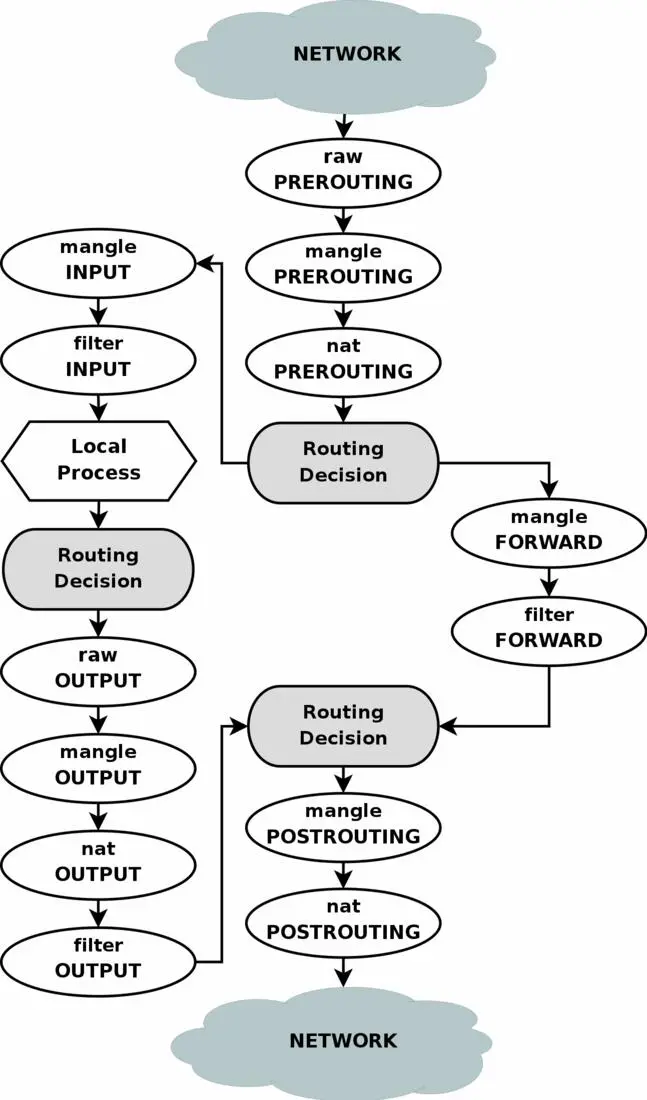Oskar Andreasson - Iptables Tutorial 1.2.2
- Название:Iptables Tutorial 1.2.2
- Автор:
- Жанр:
- Издательство:неизвестно
- Год:неизвестен
- ISBN:нет данных
- Рейтинг:
- Избранное:Добавить в избранное
-
Отзывы:
-
Ваша оценка:
Oskar Andreasson - Iptables Tutorial 1.2.2 краткое содержание
Iptables Tutorial 1.2.2 - читать онлайн бесплатно полную версию (весь текст целиком)
Интервал:
Закладка:
CautionDo not use the INPUT chain to filter on in the previous scenario! INPUT is meant solely for packets to our local host that do not get routed to any other destination.
We have now seen how the different chains are traversed in three separate scenarios. If we were to figure out a good map of all this, it would look something like this:

To clarify this image, consider this. If we get a packet into the first routing decision that is not destined for the local machine itself, it will be routed through the FORWARD chain. If the packet is, on the other hand, destined for an IP address that the local machine is listening to, we would send the packet through the INPUT chain and to the local machine.
Also worth a note, is the fact that packets may be destined for the local machine, but the destination address may be changed within the PREROUTING chain by doing NAT. Since this takes place before the first routing decision, the packet will be looked upon after this change. Because of this, the routing may be changed before the routing decision is done. Do note, that all packets will be going through one or the other path in this image. If you DNAT a packet back to the same network that it came from, it will still travel through the rest of the chains until it is back out on the network.
TipIf you feel that you want more information, you could use the rc.test-iptables.txt script. This test script should give you the necessary rules to test how the tables and chains are traversed.
Mangle table
This table should as we've already noted mainly be used for mangling packets. In other words, you may freely use the mangle targets within this table, to change TOS (Type Of Service) fields and the like.
CautionYou are strongly advised not to use this table for any filtering; nor will any DNAT, SNAT or Masquerading work in this table.
The following targets are only valid in the mangle table. They can not be used outside the mangle table.
• TOS
• TTL
• MARK
• SECMARK
• CONNSECMARK
The TOS target is used to set and/or change the Type of Service field in the packet. This could be used for setting up policies on the network regarding how a packet should be routed and so on. Note that this has not been perfected and is not really implemented on the Internet and most of the routers don't care about the value in this field, and sometimes, they act faulty on what they get. Don't set this in other words for packets going to the Internet unless you want to make routing decisions on it, with iproute2.
The TTL target is used to change the TTL (Time To Live) field of the packet. We could tell packets to only have a specific TTL and so on. One good reason for this could be that we don't want to give ourself away to nosy Internet Service Providers. Some Internet Service Providers do not like users running multiple computers on one single connection, and there are some Internet Service Providers known to look for a single host generating different TTL values, and take this as one of many signs of multiple computers connected to a single connection.
The MARK target is used to set special mark values to the packet. These marks could then be recognized by the iproute2 programs to do different routing on the packet depending on what mark they have, or if they don't have any. We could also do bandwidth limiting and Class Based Queuing based on these marks.
The SECMARK target can be used to set security context marks on single packets for usage in SELinux and other security systems that are able to handle these marks. This is then used for very fine grained security on what subsystems of the system can touch what packets et cetera. The SECMARK can also be set on a whole connection with the CONNSECMARK target.
CONNSECMARK is used to copy a security context to or from a single packet from or to the whole connection. This is then used by the SELinux and other security systems to do more fine-grained security on a connection level.
Nat table
This table should only be used for NAT (Network Address Translation) on different packets. In other words, it should only be used to translate the packet's source field or destination field. Note that, as we have said before, only the first packet in a stream will hit this table. After this, the rest of the packets will automatically have the same action taken on them as the first packet. The actual targets that do these kind of things are:
• DNAT
• SNAT
• MASQUERADE
• REDIRECT
The DNAT target is mainly used in cases where you have a public IP and want to redirect accesses to the firewall to some other host (on a DMZ for example). In other words, we change the destination address of the packet and reroute it to the host.
SNAT is mainly used for changing the source address of packets. For the most part you'll hide your local networks or DMZ, etc. A very good example would be that of a firewall of which we know outside IP address, but need to substitute our local network's IP numbers with that of our firewall. With this target the firewall will automatically SNAT and De-SNAT the packets, hence making it possible to make connections from the LAN to the Internet. If your network uses 192.168.0.0/netmask for example, the packets would never get back from the Internet, because IANA has regulated these networks (among others) as private and only for use in isolated LANs.
The MASQUERADE target is used in exactly the same way as SNAT, but the MASQUERADE target takes a little bit more overhead to compute. The reason for this, is that each time that the MASQUERADE target gets hit by a packet, it automatically checks for the IP address to use, instead of doing as the SNAT target does - just using the single configured IP address. The MASQUERADE target makes it possible to work properly with Dynamic DHCP IP addresses that your ISP might provide for your PPP, PPPoE or SLIP connections to the Internet.
Raw table
The raw table is mainly only used for one thing, and that is to set a mark on packets that they should not be handled by the connection tracking system. This is done by using the NOTRACK target on the packet. If a connection is hit with the NOTRACK target, then conntrack will simply not track the connection. This has been impossible to solve without adding a new table, since none of the other tables are called until after conntrack has actually been run on the packets, and been added to the conntrack tables, or matched against an already available connection. You can read more about this in the The state machine chapter.
This table only has the PREROUTING and OUTPUT chains. No other chains are required since these are the only places that you can deal with packets before they actually hit the connection tracking.
NoteFor this table to work, the iptable_raw module must be loaded. It will be loaded automatically if iptables is run with the -t raw keywords, and if the module is available.
NoteThe raw table is a relatively new addition to iptables and the kernel. It might not be available in early 2.6 and 2.4 kernels unless patched.
Filter table
The filter table is mainly used for filtering packets. We can match packets and filter them in whatever way we want. This is the place that we actually take action against packets and look at what they contain and DROP or /ACCEPT them, depending on their content. Of course we may also do prior filtering; however, this particular table is the place for which filtering was designed. Almost all targets are usable in this table. We will be more prolific about the filter table here; however you now know that this table is the right place to do your main filtering.
User specified chains
If a packet enters a chain such as the INPUT chain in the filter table, we can specify a jump rule to a different chain within the same table. The new chain must be userspecified, it may not be a built-in chain such as the INPUT or FORWARD chain for example. If we consider a pointer pointing at the rule in the chain to execute, the pointer will go down from rule to rule, from top to bottom until the chain traversal is either ended by a target or the main chain (I.e., FORWARD, INPUT, et cetera) ends. Once this happens, the default policy of the built-in chain will be applied.

If one of the rules that matches points to another userspecified chain in the jump specification, the pointer will jump over to this chain and then start traversing that chain from the top to bottom. For example, see how the rule execution jumps from rule number 3 to chain 2 in the above image. The packet matched the matches contained in rule 3, and the jump/target specification was set to send the packet on for further examination in chain 2.
NoteUserspecified chains can not have a default policy at the end of the chain. Only built in chains can have this. This can be circumvented by appending a single rule at the end of the chain that has no matches, and hence it will behave as a default policy. If no rule is matched in a userspecified chain, the default behaviour is to jump back to the originating chain. As seen in the image above, the rule execution jumps from chain 2 and back to chain 1 rule 4, below the rule that sent the rule execution into chain 2 to begin with.
Each and every rule in the user specified chain is traversed until either one of the rules matches -- then the target specifies if the traversing should end or continue -- or the end of the chain is reached. If the end of the user specified chain is reached, the packet is sent back to the invoking chain. The invoking chain can be either a user specified chain or a built-in chain.
What's next?
In this chapter we have discussed several of the chains and tables and how they are traversed, including the standard built-in chains and userspecified chains. This is a very important area to understand. It may be simple, but unless fully understood, fatal mistakes can be equally easily.
The next chapter will deal in depth with the state machine of netfilter, and how states are traversed and set on packets in a connection tracking machine. The next chapter is in other words just as important as this chapter has been.
Chapter 7. The state machine
This chapter will deal with the state machine and explain it in detail. After reading through it, you should have a complete understanding of how the State machine works. We will also go through a large set of examples on how states are dealt with within the state machine itself. These should clarify everything in practice.
Introduction
The state machine is a special part within iptables that should really not be called the state machine at all, since it is really a connection tracking machine. However, most people recognize it under the first name. Throughout this chapter I will use these names more or less as if they were synonymous. This should not be overly confusing. Connection tracking is done to let the Netfilter framework know the state of a specific connection. Firewalls that implement this are generally called stateful firewalls. A stateful firewall is generally much more secure than non-stateful firewalls since it allows us to write much tighter rule-sets.
Читать дальшеИнтервал:
Закладка:










